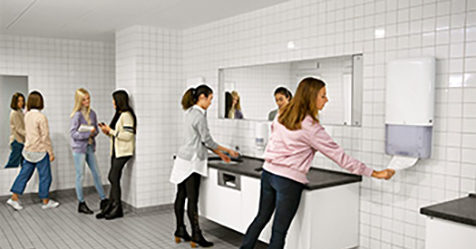Many in the professional cleaning and building management industries believe that never having to touch a handle in the bathroom is the key benefit of sensor-controlled faucets, toilets, and urinals. Because of disease and germs, a fixture that can protect health is the perfect technology for a 21st-century restroom.
While promoting proper hygiene is important, it’s not the only reason some industry professionals consider hands-free options for their facilities’ restrooms. Another perceived benefit of sensor-controlled fixtures is that they save water. This is important because water consumption is a growing concern in many parts of the United States and around the world.
However, some people question whether sensor-controlled restroom fixtures really reduce water consumption. For instance, many of us have observed what is known in the plumbing industry as a “phantom flush.” This occurs when a sensor-controlled urinal or toilet flushes on its own because the lighting changes or a person walks by the fixture. It would not be so bad if this happened once-in-a-while, but phantom flushes are actually common. As a result, sensor-controlled fixtures can actually use more water than manually-operated systems.
Sensor-Controlled Study
In 2010 Bill Gauley of Veritec Consulting Inc. and John Koeller of Koeller & Co. released a report that addressed whether sensor-controlled systems use more, less, or about the same amount of water as manually operated systems. The report was based on a 23-month study conducted at an office building in Tampa, FL. The study, which concluded in 2009, compared water usage from manually operated fixtures that were already installed throughout the building to quality sensor-controlled fixtures that were installed by the study team on the seventh floor of the building.
The study yielded some unexpected results. For instance, when the toilets were retrofitted with sensor controls, researchers found the units were using 3.5 gallons of water per flush—more than twice the amount they were designed to use. They discovered that the wrong valves and diaphragms had been installed, which was eventually corrected. Additionally, readings of the meters indicated that water use in the facility fluctuated far more than ever assumed. While there was an expected decrease in water consumption during the summer months when people were out of the office on vacation, at other times there were significant, unexplained increases in water use.
In their report, “Sensor-Operated Plumbing Fixtures: Do They Save Water?” Gauley and Koeller published the following:
“While the results achieved in this relatively small-scale project may not necessarily be indicative of results that might be achieved in other projects, they clearly indicate a significant increase in water demands when manually-operated plumbing fixtures on the seventh floor were converted to sensor-operated models. The total average daily demand of the men’s and ladies’ washrooms almost doubled from 654 to 1,243 gallons per day when all faucets, urinals, and toilets were converted to sensor-operated units.”
The Other Side of the Coin
Gauley and Koeller’s study has received considerable attention, and its findings have been met with some concerns from manufacturers of sensor-controlled faucets as well as green and sustainability advocates. For instance, some manufacturers say the secret to saving water when it comes to sensor-controlled faucets is timing, and not the actual water flow.
Lavatory faucets are mandated to use no more than 2.2 gallons of water per minute, according to John Couture, formerly an engineer with Symmons Industries, Inc., a manufacturer of commercial and residential plumbing fixtures based in Braintree, MA. “It’s all a timing thing, gallons per minute—time versus flow rate,” he explained in a 2009 article. “So, when you look at sensor faucets, they are actually timed at a quarter gallon per cycle,” which is not possible with a manually-operated faucet.
Essentially, he suggests, many sensor-controlled restroom faucets save water by operating on 10- to 15-second intervals; after 10 or 15 seconds, if the system does not detect a user, it turns the water off. The savings can be significant when the sensor-controlled faucet turns off the water after 10 or 15 seconds, which results in less than a quarter of the 2.2 gallons of water being used per minute. With a manual faucet, it is likely the water will continue to flow—and may not even be turned off by the user—resulting in considerably more water used and wasted.
Recommendations
There are differing views, but it is possible new technologies will help to ensure that sensor-controlled faucets do indeed reduce water consumption. However, according to Gauley and Koeller, sensor-controlled fixtures should not be expected to reduce water demands. Further, consumers, building owners, and managers should carefully examine manufacturers’ claims that sensor-controlled systems can save water.
If water efficiency and reduction is the goal, consumers, building owners, and managers are advised to select restroom fixtures specifically designed for this purpose, such as high-efficiency toilets. They can also avoid water urinals, which are not sensor-controlled and have no flush controls whatsoever.
Water-Efficient Alternatives
Clearly, new technology offers benefits, but high-tech sensors alone may not provide a complete solution to efficient water usage. So the question now is the following: What options do building managers have in order to reduce the amount of water used in their facilities? Fortunately, there are several:
- Older flush urinals can use up to 35,000 gallons of water per urinal per year. Replacing these urinals with low-flow systems can cut this amount in about half. However, no-flow or no-water urinals, which have no flush valves or related water-delivery systems, reduce this amount to zero.
- Federal regulations now require that newly installed toilets use 1.6 gallons of water per flush or less. However, high-efficiency toilets—and there are many different types to choose from, including dual-flush and pressure-assisted—use about 1.3 gallons or less per flush.
- The typical faucet releases about 2.5 or more gallons of water per minute; by installing a very inexpensive aerator, this amount can be reduced to as little as half-a-gallon per minute with minimal impact on user satisfaction. Aerators may also be installed in shower heads and similar fixtures if present in a facility.
- For facilities with landscaping, automatic drip-type irrigation systems can help building owners reduce water consumption considerably. With these systems, spray heads are eliminated and water is delivered directly to the roots of plants and vegetation.
- Water brooms can be used in place of pressure washing floor surfaces. Water brooms are designed to use about one-tenth the water of a hose. They do this by turning ordinary tap water into high-pressure cleaning devices.
Regardless of the study results, one last option to help reduce water consumption is to educate building users that water efficiency requires everyone to use water more responsibly. Placement of placards and notices near water-using products provides a gentle reminder that we all must do our share to protect our most valuable resource.




